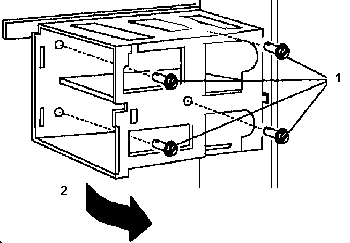|
(He steals from me, I loot from him. Perfect) 162/163 Error Code Combination (to Spencer's 8580 site) Battery Orientation in Speaker Battery Assembly 8580 Battery Cross Reference (to Spencer's 8580 site) Time stands still (System time doesn't change) 8580 Floppy Types (to Spencer's 8580 site) XGA-2 Install attempt failing after copy of ADF files (to Spencer's 8580 site) Repair of PS/2 1.44mb Floppy (to Al Savage) Comments on Mitsubishi and Alps Floppy Drives Replacing Capacitors Pinout for Speaker Battery Assembly Header Clear a Power-On Password Open an 8580 Remove Front Bezel Open a Locked 8580 Case >16MB on an 8580 under Linux 161/163 Error Code Combination Trivia
Comments on ALPS and Mitsubishi Floppy Drives >There was some dust on the fdd controller below the fan, but I've seen pcb's in even worse condition. This machine seems to be on duty not for long time. I also cleaned the drive (mitsubishi type), but all didn't help. Peter said
>Ask somebody for the drive from an unused 8580. But "unused" does not automatically mean "in working condition". In the worst case they placed the computer there *because* it showed odd errors too. Worth a try nontheless. > How long is the half life time of these drives? They seem to die quite often! The ALPS drives had a much higher error rate than the Mitsu-drives.
The ALPS are also much more wicked to take apart due to the amount of "0"-sized
Philips screws. The Mitsu is a somewhat cheap design, but far more easier
to service. Both drives are dust collectors due to the lack of a dust-shield
covering the disk slot when no floppy is in the drive.
Replacing
Capacitors
I found it easiest to cut the caps in two with flush-cutting diagonals, then remove the rubber seal and get access to the wire stubs from the top. >For replacment of the 22uF and 1uF caps, I used surface-mountable electrolytic caps of the same type. However, 0.22uF electrolytic caps are difficult to obtain, so I used ceramic caps instead. I also used ceramics there, and tantalum chips for the others. Just a note that I occasionally repeat: the best way of
locating bad electrolytics is by checking ESR, effective series resistance.
A dandy little meter for this is a kit made by Dick Smith Electronics in
Australia, and sold by various dealers around the world.
Floppy Support Structure 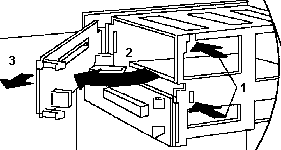
Battery Orientation in Speaker Battery Assembly 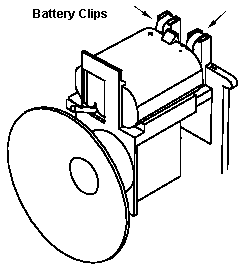
The contacts on the battery point to the rear, where they press against
the spring clips.
The Day Time Stood Still (Time does not Change) j131 asked I am using this machine under linux (debian 2.2.r3) as a sort of occasional (in fact rather rarely turned on) home-file-server. The only symtom is that: _the time at powerup is the same as it was at powerdown_. Neither BIOS nor OS complains... Only me... There are no 161/163 errors. Alfred Arnold replies
with "just the facts"
Pinout for Battery/Speaker connector  6 pin Header
6 pin Header
1 Gnd 4 NC 2 Gnd 5 Clear 3 +6v 6 NC
Clear a Power-On Password 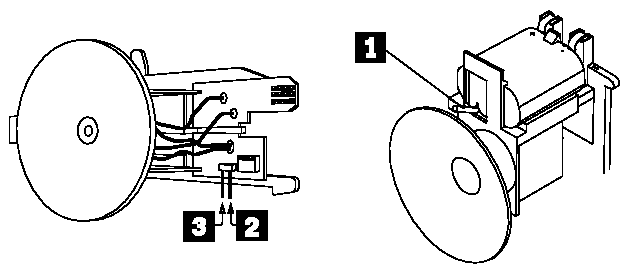
Model 50, 60, 70, 80 Override Jumper
With the assembly shorted, power-on the computer. This erases
the power-on password. Remove the short after POST is finished.
Open a 8580 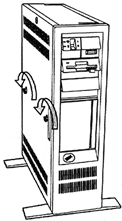
Use a coin or large standard screwdriver to turn the two
large screwheads to the left. After they are both loose (they're captive
screws, they won't come out), pivot the side cover on the bottom hinges
until the top edge has cleared the case. Pull up and out.
If the lock in the top center of the cover is locked, look at the next section. Remove Front
Bezel
NOTE This bezel is NOT
like the 95 bezel where there are upper pivots. There is a single catch
to the right of the power switch. Think of the two bottom catches and the
top catch in the same way you'd pick up a bowling ball (which I haven't
done since High School). These "fingers" grip the frame of the case and
pull the bezel onto it.
Open a Locked 8580 (and 8560/8565) Tony Ingenoso sez: It's very easy if there's no card in the bottom slot, less easy if there is. 1) Flip the machine upside down
ALTERNATIVE APPROACH: -- drill a
couple of small holes in the bottom of the case where the cover tabs are
located, then use these holes to apply pressure to the tabs to get them
to release. This doesn't involve having to waste something in slot 8, but
it does involve mangling the case to a very minor degree. Use a depth gauge!!!
If you drill through the retaining tab, there'll be nothing to push on
;->
>16MB on a 8580 under Linux Ed Avis takes time out from the pub and mistakenly admits: I upgraded my 8580 from 12MB to 24MB RAM and Linux's ibmmca.c SCSI driver stopped working. (I have a couple of Spock Primes in there.) To cut a long story short, this is caused by a DMA limitation on the 8580 (and possibly other early PS/2s) that restricts DMA to the lower 16Mbyte of RAM. Michael Lang, the maintainer of the driver, was very helpful and after trying various bugfixes, suggested changing the flag 'unchecked_isa_dma' to 1. I'm not sure what this does, but it fixed the problem. So if you have >16Mbyte RAM and you find that Linux crashes on boot with errors from IBM MCA SCSI, edit the file ibmmca.h in the kernel sources and change a couple of lines to read: unchecked_isa_dma: 1, /*32-Bit Busmaster */ \ instead of 'unchecked_isa_dma: 0'. Hopefully this will become
an option in later versions of the kernel - or maybe with the new 2.4 kernel
and 4.0 ibmmca driver it is not needed.
161/163 Trivia Peter "remembered" this- If the floppy *seems to start* booting (LED lights up, FDD whirrs for a second) after the beeps and 161 / 163 display but then "hangs there" press [F1] to force loading. The older Mod. 80 seem to have a *slighly* different BIOS that not always auto-loads even a valid reference disk. After 161/163 errors the first loading of the reference disk *may* take up to 90 seconds - because the machine BIOS uses the lowest transfer rate available, because it is uncertain about the type of FDD. If the F1 fails and a second F1 brings you into IBM ROM BASIC suspect
|
